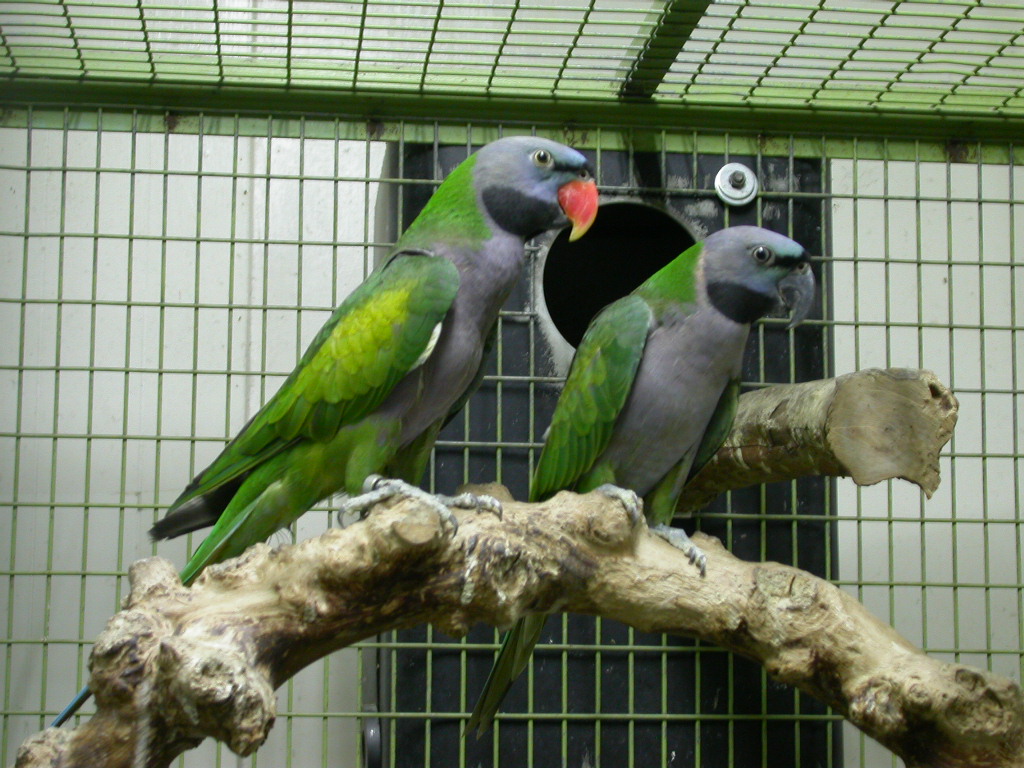
Lord Derby's parakeet, orDerbyan parakeet(Psittacula derbiana)
Phylum —chordata
Class — aves
Order — psittaciformes
Family — psittaculidae
Genus – psittacula
Appearance
Lord Derby's parakeets are 45–50 cm (18–20 in) in length and are sexually dimorphic. They have a mostly green plumage over their dorsal surface (i.e. from behind), black lores and lower cheeks, a bluish-purple crown and pale yellow eyes. The throat, breast, abdomen and under-wing coverts are greyish blue to lavender. The thighs and vent area are yellowish green with blue edging on some of the feathers. The tail feathers are shades of green, some edged with blue. Male birds have a red upper mandible with a yellow tip, while the lower mandible is black. The females have an all-black beak.
Immature Lord Derby's parakeets are duller in color than the adults. Juvenile birds have green crowns, orange-red upper and lower mandible (beak), and their irises are dark and do not lighten until they reach maturity between two and three years of age.
Habitat
The Derbyan parakeet is found in northeast Assam, southeast Tibet, and western China in the provinces of Szechwan and Yunnan.
Behavior
In the wild, the Derbyan parakeets live in small flocks of up to 50 birds and are very social. They do seem to prefer birds as companions and can seem rather aloof, shying away from human handling. They have a generally peaceful personality and make excellent aviary birds.
Diet
Lord Derby's parakeets feed on fruits, berries, seeds, and leaf buds, occasionally foraging in gardens and fields.
Reproduction
The Derbyan parakeets reach maturity at about two years of age. They will readily breed in captivity and are excellent parents. In the wild they build their nests in the holes in trees. The female will lay an average of four eggs. The young hatch in about 23 days and leave the nest in about 50 days.
In captivity
Derbyan parakeet can live up to 30 years. They'll spend their life without many problems, thanks to their hardy and healthy nature, and their ability to adapt to different conditions. You must not neglect their need for space, for social interaction and a balanced, healthy diet. As a sign of precaution, take notice of these potential symptoms – apathy, crusted and runny eyes, or dirty vent. As always, good hygiene is a top priority and ensures no skin-borne diseases will affect your pet.
These are one of the calmer, shyer parakeet breeds, but are still very intelligent and energetic. It might take them a little longer to adapt and socialize with their owner and the new environment, but when they do, you will get to know their lovely, fun side. It is, in general, a parrot with balanced traits – it’s energetic, inquisitive and loves to play, but it can also be affectionate, calm and surprisingly cuddly. With enough given attention and love, you’ll slowly get to know your pet, and fall in love much faster.
Feeding these parrots a healthy diet is essential. In the wild they eat a variety of foods and it should be no different when kept in captivity as pets. Most owners will feed their pet Derbyans a diet of seeds, pellets, fresh fruits, and vegetables.
 Russian
Russian
 English
English























